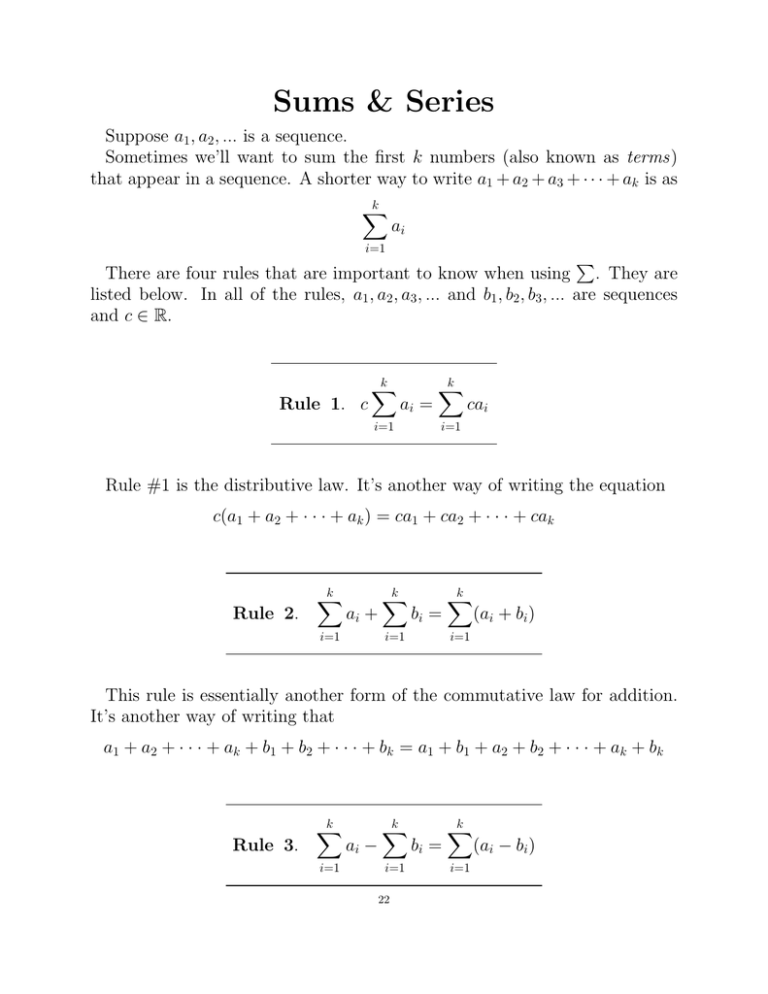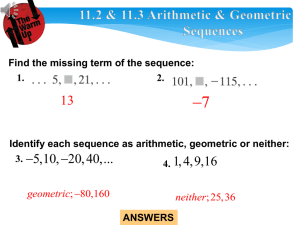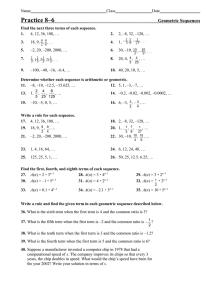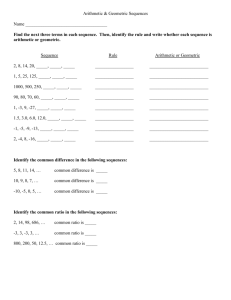Sums & Series
advertisement

Sums & Series Suppose a1 , a2 , ... is a sequence. Sometimes we’ll want to sum the first k numbers (also known as terms) that appear in a sequence. A shorter way to write a1 + a2 + a3 + · · · + ak is as k � ai i=1 � There are four rules that are important to know when using . They are listed below. In all of the rules, a1 , a2 , a3 , ... and b1 , b2 , b3 , ... are sequences and c ∈ R. Rule 1. c k � ai = i=1 k � cai i=1 Rule #1 is the distributive law. It’s another way of writing the equation c(a1 + a2 + · · · + ak ) = ca1 + ca2 + · · · + cak Rule 2. k � ai + i=1 k � bi = i=1 k � (ai + bi ) i=1 This rule is essentially another form of the commutative law for addition. It’s another way of writing that a1 + a2 + · · · + ak + b 1 + b 2 + · · · + b k = a1 + b 1 + a2 + b 2 + · · · + ak + b k Rule 3. k � i=1 ai − k � i=1 22 bi = k � i=1 (ai − bi ) Rule #3 is a combination of the first two rules. To see that, remember that −bi = (−1)bi , so we can use Rule #1 (with c = −1) followed by Rule #2 to derive Rule #3, as is shown below: k � i=1 ai − k � k � bi = i=1 ai + i=1 k � = k � i=1 −bi (ai + (−bi )) i=1 k � = i=1 Rule 4. k � (ai − bi ) c = kc i=1 The fourth rule can be �ak little tricky. The number c does not depend on i — it’s a constant — so i=1 c is taken to mean that you should add the first k terms in the sequence c, c, c, c, .... That is to say that k � i=1 * * * * c = c + c + · · · + c = kc * * * * * * * * * Sum of first k terms in an arithmetic sequence If a1 , a2 , a3 , ... is an arithmetic sequence, then an+1 = an + d for some d ∈ R. We want to show that k � k ai = (a1 + an ) 2 i=1 23 To show this, let’s write the sum in question in two different ways: front-toback, and back-to-front. That is, k � ai = a1 + (a1 + d) + (a1 + 2d) + · · · + (ak − 2d) + (ak − d) + ak ai = ak + (ak − d) + (ak − 2d) + · · · + (a1 + 2d) + (a1 + d) + a1 i=1 and k � i=1 Add the two equations above “top-to-bottom” to get 2 k � i=1 ai = [a1 + ak ] + [a1 + ak ] + [a1 + ak ] + · · · + [a1 + ak ] + [a1 + ak ] + [a1 + ak ] Count and check that there are exactly k of the [a1 + ak ] terms in the line above being added. Thus, 2 k � ai = k[a1 + ak ] i=1 which is equivalent to what we were trying to show: k � i=1 k ai = (a1 + ak ) 2 Example. What is the sum of the first 63 terms of the sequence −1, 2, 5, 8, ...? The sequence above is arithmetic, because each term in the sequence is 3 plus the term before it, so d = 3. The first term of the sequence is −1, so a1 = −1. Our formula an = a1 +(n−1)d tells us that a63 = −1+(62)3 = 185. Therefore, 63 � 63 63 ai = (−1 + 185) = (184) = 5, 796 2 2 i=1 Example. The sum of the first 201 terms of the sequence 10, 17, 24, 31, ... 201 equals 201 2 (10 + 1410) = 2 (1420) = 142, 710. 24 * * * * * * * * * * * * * Geometric series It usually doesn’t make any sense at all to talk about adding infinitely many numbers. But if a1 , a2 , a3 , ... is a geometric sequence where an+1 = ran and −1 < r < 1, then we can make sense of adding all of the terms of the sequence together. (We’ll see why later in the semester.) We will use the symbols ∞ � ai i=1 to represent adding all of the numbers in the sequence a1 , a2 , a3 , ..., and we call this infinite “sum” a series. For the moment, let S = a1 + a2 + a3 + a4 + · · ·. Then S = a1 + ra1 + r2 a1 + r3 a1 + · · · and using the distributive law we have rS = ra1 + r2 a1 + r3 a1 + · · · Thus, S − rS = a1 . Since the distributive law tells us that S − rS = S(1 − r), a1 . We have shown that we have S(1 − r) = a1 , or in other words, S = 1−r ∞ � ai = i=1 a1 1−r Examples. • The sum of the terms in the sequence 1, 12 , 14 , 18 , ... equals 2. We know the sequence is geometric, follows the rule an+1 = 21 an , and that the first term in the sequence equals 1. Thus 1+ 1 1 1 1 + + + ... = 2 4 8 1− 25 1 2 = 1 1 2 =2 5 • The sum of the terms in the sequence 5, 53 , 59 , 27 , ... equals 5 5 15 1 = 2 = 2 1− 3 3 Caution. If a1 , a2 , a3 , ... isn’t geometric, or if it is but either r ≥ 1 or r ≤ −1, then ∞ � ai i=1 probably doesn’t make sense. * * * * * * * 26 * * * * * * Exercises 1.) If the sum of the first 3976 terms of the sequence a1 , a2 , a3 , ... equals 114, then what is the sum of the first 3976 terms of the sequence 32 a1 , 32 a2 , 23 a3 , ...? Determine what each of the following eight series equals. 2.) 50 � 3 i=1 3.) 100 � 49 i=1 4.) 78 � (−2) i=1 5.) 40 � i i=1 6.) 100 � i i=1 7.) 900 � i i=1 8.) 5 � i=1 (2i − 1) 27 9.) 4 � i=1 (i2 − 2) 10.) What is the sum of the first 701 terms of the sequence −5, −1, 3, 7, ...? 11.) What is the sum of the first 53 terms of the sequence 140, 137, 134, 131, ...? 12.) What is the sum of the first 100 terms of the sequence 4, 9, 14, 19, ...? 13.) What is the sum of the first 80 terms of the sequence 53, 54, 55, 56, ...? 5 14.) Sum all of the terms of the geometric sequence 20, 5, 45 , 16 , .... 405 15.) Sum all of the terms of the geometric sequence 120, 90, 135 2 , 8 , .... 28 56 16.) Sum all of the terms of the geometric sequence 7, 14 3 , 9 , 27 , .... 17.) Sum all of the terms of the geometric sequence 25, 15, 9, 27 5 , .... 18.) Sum all of the terms of the geometric sequence 1, − 12 , 14 , − 18 , .... 19.) Suppose that you expect to pay $400 for gas for your car next year, and that each year after that you plan your yearly gas expenditures will increase by $20. How much will you spend on gas in the next 8 years? 20.) Suppose you are entertaining two different job offers. Job A has a starting salary of $20,000 and assures you of a raise of $1,000 per year. Job B offers you a starting salary of $23,000, with a yearly raise of $725. Which job will pay you more over the first ten years? How much more? 21.) An oil well currently produces 5 million gallons of oil per year, but the well is drying up, and each year it will produce 60% of what it did the year before. How much oil can be produced from the well before it is completely dry? 28




